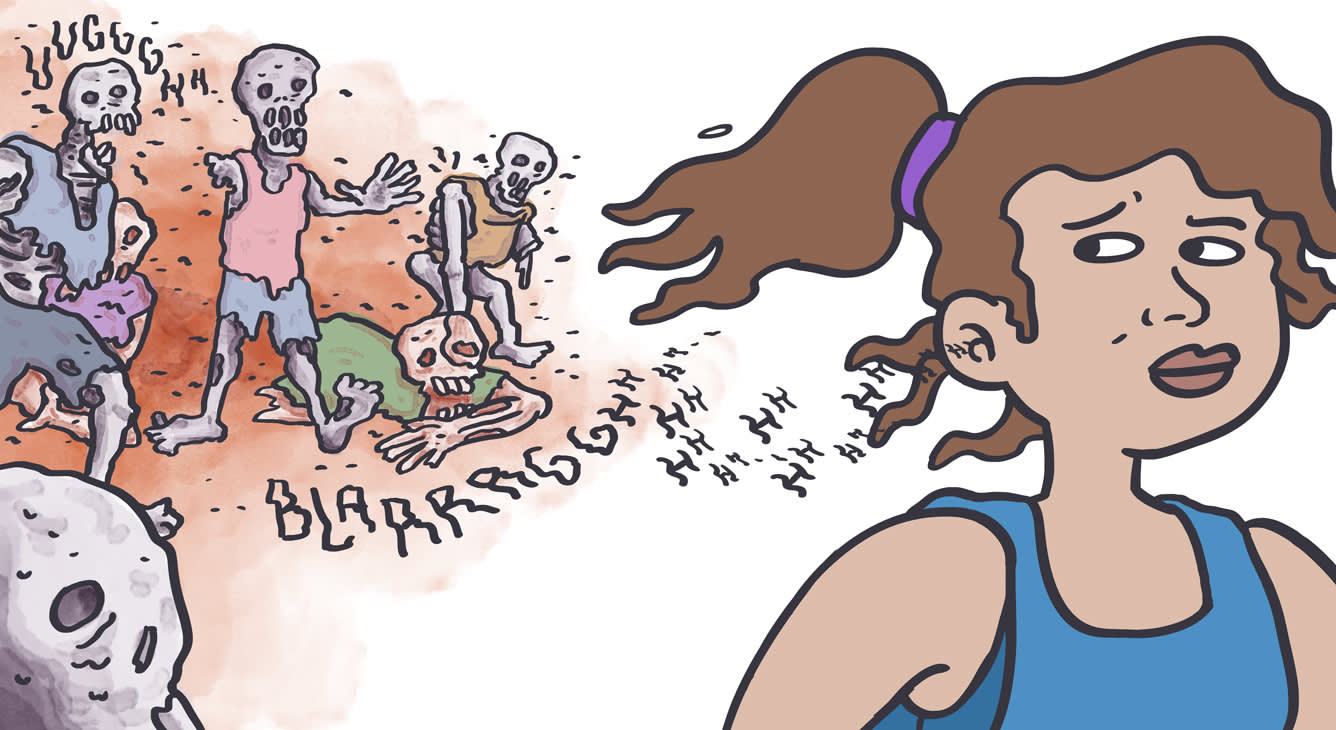While he was working on Pride and Prejudice and Zombies, Lionsgate’s 2016 movie adaptation of the Seth Grahame-Smith best seller, dialogue supervisor Brian Bowles was determined to find a bold new sound for the core group of undead.
“We had video game guys doing monster screams, and they were great,” he says. “But we were looking for zombie noises that would just put it through the roof.”
Bowles found them outside the usual voiceover circles and hired Scott Ian — guitarist and vocalist for the thrash-metal band Anthrax — to spend an afternoon growling in a recording studio.
To Bowles’ delight, the rock star (and, it so happens, a major zombie enthusiast who had a recent cameo in AMC’s The Walking Dead) was capable of producing some next-level zombie noises. “He even gave us some cool harmonics too, where his voice produced a low sound and a high sound at the same time,” Bowles recalls. Listen closely and you’ll hear Ian’s heavy metal shrieks scattered throughout the Jane Austen monster mashup.
As zombies continue to generate otherworldly profits — between movies, TV, video games, apps, comics, and Halloween costumes, the market is estimated to be worth in the tens of billions of dollars annually — the pressure is on to render the undead, and their voices, freakier and scarier than before.
Listen closely and you’ll hear [Anthrax’s Scott] Ian’s heavy metal shrieks scattered throughout the Jane Austen monster mashup.
In the recording booth, audio wizards like Bowles are constantly on the lookout for the next big thing in apocalyptic audioscapes. “People have a preconceived idea of what a zombie sounds like now,” Bowles says. “So coming up with a new variation or twist is its own challenge.”
That’s a tall order, as zombie sounds have been scaring the pants off audiences as far back as talkies have been made. In 1932, United Artists public relations director Hal Horne was looking for an effective way to publicize the studio’s new Bela Lugosi horror movie, White Zombie, the first feature-length zombie thriller. By all accounts, Horne succeeded, luring thousands of New Yorkers to the Rivoli Theater, all of them drawn by the “sudden appearance of nine zombies” above the theater marquee, Horne later wrote.
The girls were “dressed in white flowing robes” and the men looked as if “they had been dug up from the ground,” but the stunt was brought to life by blasting “White Zombie” sound effects through loudspeakers. This included “the screeching of vultures, the grinding of the sugar mill and the beating of the tom toms, among other nerve-wracking sounds.”

But it would take almost four more decades for the modern zombie movie to rise, with the release in 1968 of Night of the Living Dead, the cult classic from director George A. Romero that came to define the genre.
“It set up a lot of the rules as far as having to shoot them in the head and how they crave human flesh,” says Fangoria writer Sean Abley, who adds that the zombies in that film were mostly quiet.
Sound design grew more complex in the two sequels, 1978’s Dawn of the Dead and 1985’s Day of the Dead, where zombies began to emit their now familiar hunger moans. But arguably the most iconic of all zombie sounds — that bellowing cry of “BRAAAAINS!!!” — did not actually appear in a Romero film. The line and its permutations originated in 1985’s The Return of the Living Dead.
Produced by Romero’s former business partner John Russo and directed by Dan O’Bannon, Return diverged sharply from the Romero playbook by adding a heaping dash of black comedy and rock ‘n’ roll to the mix. (A number of notable punk bands from the era, The Cramps and The Damned among them, contributed songs to the soundtrack.)
Return also lays claim to being the first movie in which zombies are capable of forming words at all. In one scene, a female zombie strapped to a morgue slab even speaks full sentences. After being asked why she kills, Fangoria’s Abley says, “[the captured zombie] goes, ‘Braaains!!! We need brains because we’re in so much pain and it makes us feel better!’”
Not much about zombie sounds changed until 2002, when Danny Boyle’s post-apocalyptic chiller 28 Days Later…introduced “fast zombies,” the result of a mysterious “rage virus” that infects much of the planet. The film and its sequels were big hits, and the fast-zombie strain spread in video games like The Last of Us and Call of Duty Black Ops II.
“They used to just stumble around and moan and groan,” says Peter Brown, a supervising sound editor who helped bring fast zombies to life in the 2006 movie World War Z. “But these zombies were running fast, like guys on a meth binge.”
“We’d tie a piece of meat to a board and we’d let them get close, and they would snap at the meat.”
To achieve that predatory effect, Brown layered animal sounds — jaguars, wild boars, even a whale to give the impression of a zombie horde in the distance — onto vocalizations produced by a group of actors. Many of those sounds come from pre-existing libraries, but on occasion it required going directly to the source.
“We went up to an animal wranglers ranch and they had a couple of wolves on hand,” says Brown, who also oversaw sound for Scouts Guide to the Zombie Apocalypse in 2015. “We’d tie a piece of meat to a board and we’d let them get close, and they would snap at the meat. It makes the human sounds a little more vicious and violent.” But, he adds, “humans are still the best source of zombie sounds.”
That job falls to a dialogue supervisor like Bowles, who typically sends his exhausted actors home after a day of zombie recording with little-to-no voices. For Pride and Prejudice and Zombies, he says, “We would not hire people that had vocal auditions coming up the next day. We put them through the wringer, for sure.”

Snarling Zombie
Sounds
Voice-over actor Dee Bradley Baker — considered one of the best in the zombie biz — warns that the practice can easily result in permanent damage to your moneymaker. “Try finding ways to not use your vocal cords,” he says. “Use things like your sinuses or parts of your soft palate to modify or mangle your zombie sounds.” Pinching your nose, or inhaling instead of exhaling, can also produce creepy effects without shredding your throat, he says.
When truly in a pinch, sound designers are known to get behind the microphone themselves. Martyn Zub, supervising sound editor on the 2013 zombie romantic comedy Warm Bodies, created most of his own creature sounds.
“I’d sit in a dark room looking at the film with a microphone in my hand and try to bring up all the zombie nature in my body,” says Zub, who believes his background singing in an Australian punk band uniquely prepared him for the gig.
Zub says there were “two types of zombies in Warm Bodies: generic ones that make the regular zombie sound, kind of, ‘Uhhhhggghhh.’ And then there were the Bonies, who were more evil zombies. They sounded like, ‘BLEEEEAGGHAAAAH!’"

“Yeah, it’s really tough on their voices,” says Jerry Ross, who as supervising sound editor for The Walking Dead is widely considered to be Hollywood’s reigning master of zombie soundscapes. Ross says the key lies in finding “the right talent,” and he has worked with the same group of 10 voice actors — referred to in the biz as a “loop group” — since the beginning.
Whenever a new script arrives, the performers scramble to claim any walkers they find particularly memorable. “A lot of it comes down to them wanting to be made into action figures,” says Ross with a chuckle. “The writers get pretty creative: There’s Hanging-Jaw Zombie, Deeply Decaying Zombie. We get to know the special qualities of each — the level of decay or mutations within each of them — before stepping foot in a recording booth.”
Something as simple as gargling water while groaning can be frighteningly effective
To give his zombies a little something extra, Ross turns to an unlikely source: Dave, his business partner’s Dachshund-Jack Russell mix. “When we wrestle with Dave and tickle him a little bit, he goes, ‘GRHAAAAHAHRHAHHAAAA.’ Whenever the zombies feed, we put a little Dave in there for the final piece de resistance.”

Anyone else hear dog in this zombie?
Zombie
And he’s not the only one to turn to man’s best friend for zombie sounds. Brown loves English Bulldogs for their slobbering and labored breathing, and his pet Maltipoo, Poppy, makes “a lot of strange moaning and groaning sounds” that found their way into Scouts Guide.
The tricks of the trade are seemingly endless. To achieve the sound of the White Walkers in Game of Thrones (yup, those are zombies, too) Brown recorded his children “screaming in a hot tub during a windstorm.” He adds, “The bubbling gave it an eerie ambience.” Something as simple as gargling water while groaning can be frighteningly effective, and the silver lining to any nasty cold is that you can record the snotty sounds and bequeath them to a zombie at a later date.
Technology then adds the finishing touch, through layering, pitching up or down, or running the sounds through any number of zombie-esque filters like iZotope Nectar or the aptly named Krotos Dehumaniser.
“You want to use everything: your family, your sick self, pro actors, animal recordings, post-processing tools, and editing to screw the sound up as much as possible — without letting it get unhinged from the screen,” Brown says. “Bottom line, those zombies need to be believable.”







